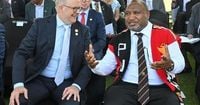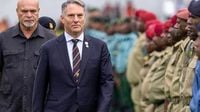In a move that could reshape the security landscape of the South Pacific, Papua New Guinea’s Cabinet has formally approved a landmark bilateral defense treaty with Australia, signaling a major step toward a formal alliance between the two neighboring nations. The decision, announced on October 2, 2025, by Papua New Guinea Prime Minister James Marape, paves the way for both countries’ leaders to sign what many observers are calling the most significant regional security agreement in decades.
The treaty, which still awaits an official signing by Prime Minister Marape and his Australian counterpart, Anthony Albanese, is only the second mutual defense pact of its kind that Australia has entered into. The only other, the historic ANZUS Treaty, was signed in 1951 with the United States and New Zealand. According to Marape, this new agreement “reflects the depth of trust, history, and shared future between our two nations.” Australian Prime Minister Albanese echoed this sentiment, noting, “Our two nations are the closest of neighbors and the closest of friends, and this treaty will elevate our relationship to a formal alliance.”
For Papua New Guinea, a country of roughly 10 million people that gained independence from Australia in 1975, the treaty marks a new chapter in a relationship long shaped by historical ties and geographic proximity. Australia, with its population of about 28 million, has remained Papua New Guinea’s largest bilateral partner, providing development aid, economic support, and security cooperation for decades. But the stakes have never been higher, as both countries—and their allies—grapple with the growing influence of China in the Pacific.
At the heart of the agreement is a mutual defense commitment: an armed attack on either Australia or Papua New Guinea will be considered a threat to the peace and security of both countries. In practical terms, this means that both nations are now formally bound to come to each other’s aid if attacked. As Defence Minister Richard Marles explained to the ABC, “What the treaty reflects is that Australia and PNG see their security lying in each other and that from PNG’s point of view, Australia is the natural security partner of choice.”
“History, geography, affinity all make that manifestly plain,” Marles said. “There is no world in which we would see any kind of attack on PNG as doing anything other than engaging our national interest. In fact, that is our history when that has happened.” He referenced Papua New Guinea’s role as a major battleground during World War II, when Australian and U.S. forces fought fiercely to repel Japanese advances in the Pacific, underscoring the deep historical roots of this contemporary alliance.
The treaty also breaks new ground in military cooperation. For the first time, Papua New Guinea citizens will be eligible to serve in the Australian Defence Force—a move that could see up to 10,000 Papua New Guineans donning Australian uniforms. This provision not only addresses Australia’s longstanding recruitment shortfall but also provides a potential pathway to Australian citizenship for those who serve. It’s a development that, as Marape put it, “strengthens PNG’s security and defence capacities as we embark on the next 50 years. It is about ensuring Papua New Guinea is safe, secure, and prepared to protect its people and borders.”
While the treaty was initially slated for signing at a ceremony in Port Moresby on September 17, 2025, a delayed Cabinet meeting meant that Marape and Albanese instead issued a joint statement affirming the agreement’s core principles. Both leaders have since indicated that the formal signing will take place soon, with anticipation running high in both capitals.
The timing of the treaty is no accident. In recent years, Australia and the United States have ramped up their military engagement with Papua New Guinea, viewing the island nation as a critical partner in efforts to counter China’s expanding footprint in the Pacific. Since 2022, Australia has stepped up diplomatic and security ties with Pacific island nations, particularly after Beijing struck a security deal with the Solomon Islands—a move that raised alarm in Canberra and Washington over the possibility of a Chinese naval base in the region.
The diplomatic chess game has only intensified as three Pacific island nations have switched diplomatic recognition from Taiwan to Beijing since 2019, further underscoring the shifting allegiances in the region. The United States and its allies have voiced concerns over China’s growing involvement in security affairs, particularly through police training and other initiatives in Fiji, Kiribati, Samoa, Solomon Islands, and Vanuatu.
But the new treaty is not without controversy. China’s embassy in Port Moresby was quick to criticize the agreement, warning that such a bilateral pact “should not be exclusive in nature, nor should it restrict or prevent a sovereign country from cooperating with a third party for any reason.” The embassy further cautioned that the treaty “should also refrain from targeting any third party or undermining its legitimate rights and interests.”
Papua New Guinea, for its part, is attempting a delicate balancing act. While deepening its security relationship with Australia and other Western allies, the Marape government remains keenly aware of the importance of its economic ties with China. As Oliver Nobetau, project director of the Australia–Papua New Guinea Network at the Lowy Institute, told the Australian Broadcasting Corporation, “The Papua New Guinea government, especially James Marape, has come out and demarcated how they see the bilateral relationships moving forward: now with the security space, siding with Australia’s traditional Western allies. And definitely in the economic and trade space, building up that relationship with China.”
Australia, meanwhile, is not stopping at Papua New Guinea. Defence Minister Marles revealed that Canberra is exploring deeper defense ties with Fiji and is making progress on a new security partnership agreement with Vanuatu, known as the Nakamal Agreement. “Beyond New Zealand, there are three [Pacific nations with defense forces], which are Papua New Guinea, Fiji and Tonga, and so the defence relationships that we have with those three countries in particular are very significant,” Marles said.
For Prime Minister Albanese, the treaty marks a major diplomatic win at a time when regional alliances are in flux and the strategic competition with China is heating up. For Papua New Guinea, it represents both an affirmation of old friendships and a bold step into a more secure future. As Marape summed up, “Today, Australia remains our single biggest bilateral partner, and consistent with our past, we are shaping our future.”
As the ink dries on this historic agreement, both nations are signaling that the security of the Pacific will be built on partnerships—old and new—grounded in trust, shared history, and a clear-eyed view of the challenges ahead.

